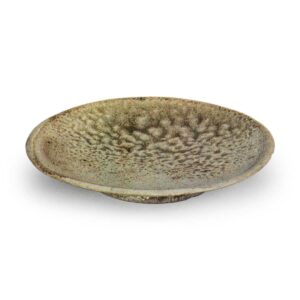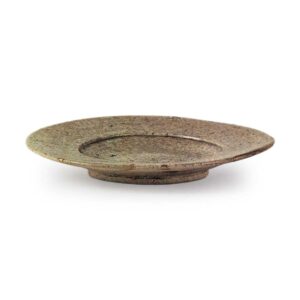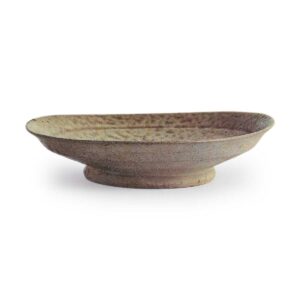
Excavated from Nishidaimon, Oaza-Denboji, Tanyo-cho, Ichinomiya-shi, Aichi
9th century
Height 2.2cm, mouth diameter 14.5cm, bottom diameter 7.2cm
Ichinomiya City Board of Education
Before the 9th century, shallow vessels used as tableware were made of vessels with rounded or obliquely outwardly straight edges.
Flat-rimmed dishes like this dish, which are connected to modern plates, appeared only in the Heian period (794-1185), along with ash-glazed bowls. They started as green- or ash-glazed porcelain ware and do not date back to the 9th century.
This is the most typical early ash-glazed dish. It is a rare and perfect dish with a light green glaze on a white base, and there is no doubt that it is from the Sanage kiln, judging from the clay and glaze tone.

Excavated from Kiln No. 5, Teiichi Kurozasa, Oaza Kurozasa, Miyoshi City, Aichi Prefecture, Japan
9th century
Height 3.0cm, Bowl diameter 16.5cm, Bottom diameter 8.2cm
Aichi Prefectural Ceramic Museum
A dish with tiers on the inner surface or both the inner and outer surfaces is called a tiered dish.
Most of the tiered dishes excavated from archaeological sites are combined with bowls, and are thought to have been used as arm rests. It is thought to be a tsingko, a type of tsingko found in the “Engishiki” (Engi Shiki) folklore of Owari-shi ware.
This piece has a white high-quality base with a light green ash glaze applied to the upper surface only by brushing. It is sharply wheel-thrown and has a broad rim band with a step on the upper surface only. This is a typical ash-glazed tiered dish.

Excavated from Kiln No. 90, Neura Kurozasa, Oaza-Fukuya, Miyoshi City, Aichi Prefecture, Japan
10th century
Height: 3.4cm, Bowl diameter: 15.2cm, Bottom diameter: 7.9cm
Aichi Prefectural Ceramic Museum
The form of this dish, which rises up with a ridge drawn on its waist, is thought to have appeared in the 10th century. Of course, this form is characteristic of Mino-Owari ash glazed pottery. This form probably came from ash-glazed bowls, which are copies of Kindo or Sabari style bowls with ridges at the waist.
It is made of dense white clay, wheel-thrown and water-ground, with a yellowish-green ash glaze applied only to the interior surface. This dish survived in the kiln of Kurozasa Kiln No. 90. It was fired by placing two pieces on top of each other on the firing table, covering the top with a shallow basin-like saggar, and lining the top with clay. Therefore, there is no risk of natural ash fall, and this is a valuable example of ash glaze from the first half of the 10th century.



